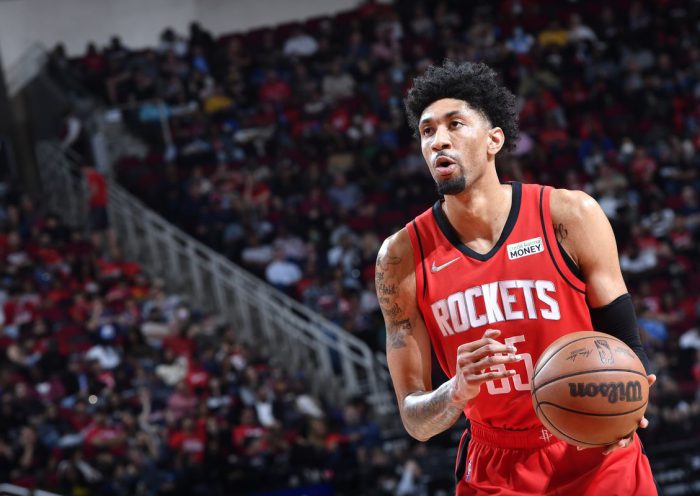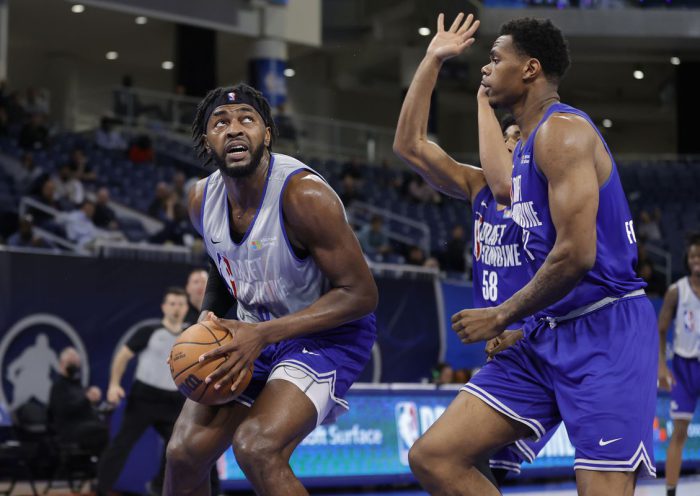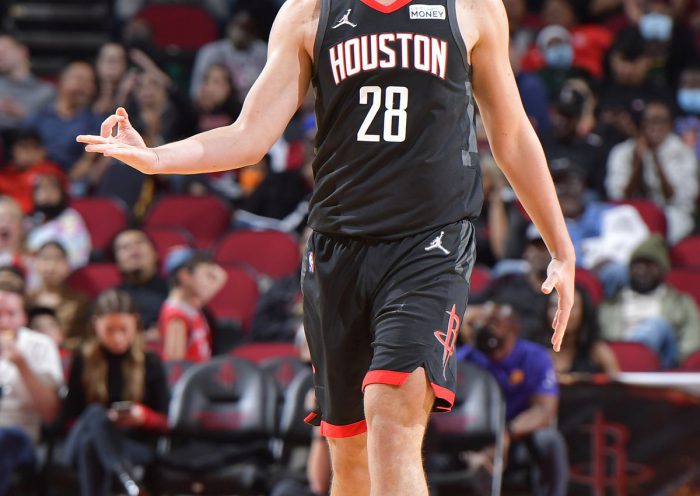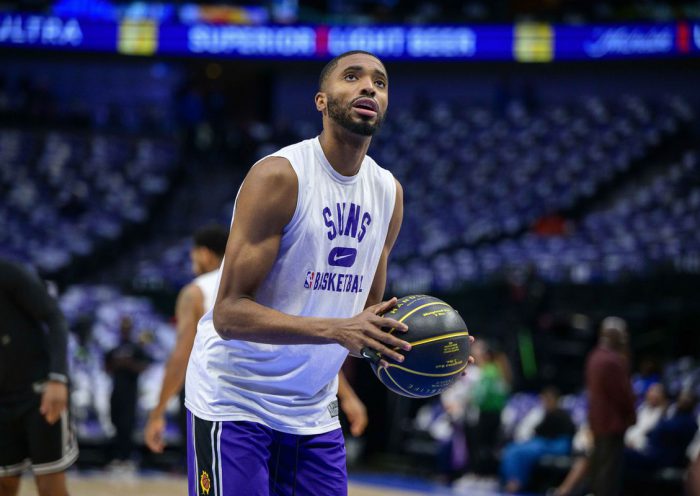sale #23 Cameron Johnson Men Nike Black 2021/22 SwingmanNBA Playoffs P Guide Warriors vs Celtics: A deep dive on a series between the league’s best defenses
In calendar year 2021, the Boston Celtics were at a crossroads.
They had a 17-19 record and were severely underachieving. Their defense was good enough to stay within the top 10 (107.5 DRTG, 9th over that period). But their offense struggled mightily (108.3 ORTG, 20th over that period). A sturdy defense was canceled out by an inept offense, resulting in them being a net neutral as a team.
Being a net neutral with a superstar such as Jayson Tatum, a two-way stalwart in Jaylen Brown, and a defensive hound such as Marcus Smart was arguably the highest degree of underachieving seen in recent years. There was absolutely no excuse for a team this talented and experienced to perform well below their station.
Offense — particularly half-court offense — was an adventure for them. A common sight would be the Celtics running their typical sets, which included the usual “HORNS” fare, “Iverson” cuts, “Exit” screens, etc. The first options would work, and the Celtics would generate points off of them.
But the crux of their half-court woes came whenever the first option didn’t work. Second-side actions and off-ball movement were rare. Plan Bs — well-thought-out and scripted ones, at least — would rarely manifest.
If there was a Plan B, it would often be Tatum or Brown working in isolation. A your-turn-my-turn mindset infected the Celtics’ half-court offense. Even if Tatum and Brown were good enough to create their own shots, it was far from being a sustainable form of scoring.
But as the calendar turned to 2022, a lot of things started to click for the Celtics. The defense — already top 10 at the time — vaulted into the elite stratosphere. Their offense started to find the playmaking and flow that were conspicuously absent in 2021.
And it was triggered by a simple personnel and role change. Once the Celtics leaned on Marcus Smart to start as their point guard and lead decision maker, it all came together rapidly.
In calendar year 2022, the Celtics went 34-12 — a .739 win percentage; only the Phoenix Suns (.787) and the Dallas Mavericks (.745) had better win-loss tallies. But more than just records, it was the Celtics’ markedly improved efficiency on both ends of the floor that turned their season around.
In 46 games played in 2022:
117.9 ORTG (2nd in 2022)102.9 half-court ORTG (4th)105.2 DRTG (1st)90.0 half-court DRTG (1st)plus-12.7 Net Rating (1st)
We all know what the Golden State Warriors offense brings to the table: heavy motion built on multiple playmaking hubs (“Delay,” DHOs, low-post splits, ball screens, etc.). The off-ball element is profound; down-screen actions, “Wide” actions, and “Rip” screens are aplenty. Cutting and slipped screens are outcomes of the advantages created by their offense, fueled by the offensive talents of Stephen Curry.
But the counters to such an intricate system are also known. Length and physicality blow up screening actions, both on and off the ball. Switching nearly everything douses the fire. Rim protection renders paint touches ineffective, if not outright eliminating them from the equation.
The Celtics — unlike any of the Warriors’ playoff opponents other than the Memphis Grizzlies (to a lesser extent) — possess those counters in spades.
Projected starting lineups
Relevant regular season team stats
Attacking the Celtics defense
The Celtics’ counters, first and foremost, are founded upon their personnel.
Smart is a hound at the point of attack. Tatum and Brown provide the requisite combination of length and switchability to blow up screening actions, crowd the passing lanes, and seamlessly move up and down the positional spectrum.
Al Horford is a versatile switch big who can hold his own on the perimeter, as well as provide competent rim protection. Robert Williams III is their ultimate rim protector who can singlehandedly wall off the paint, while also having value as an occasional switch big.
Off the bench, Grant Williams further unlocks the Celtics’ switchy nature, as well as allowing them to play their best small-ball lineup. Derrick White is a supreme screen navigator.
The Celtics bank on stagnating offenses and bleeding the shot clock. They want to force inefficiency and bad shots — and that means switching almost everything on and off the ball. Per Second Spectrum, the Celtics sKyrie Irving Jerseyswitched the most on-ball actions per 100 possessions (28.8) during the regular season.
Switching requires discipline and utmost concentration. Keeping assignments in front is paramount to their scheme in order to flatten out actions, keep things strictly an east-west endeavor instead of north-south, and force the other team to rely on shot creation.
The likes of Curry and Jordan Poole can definitely provide shot creation, but if the Celtics force the Warriors to rely primarily on their shot creators — instead of establishing their usual rhythm and flow on offense — the Celtics will take Curry and Poole beating them individually.
The Celtics weren’t much of a deep-drop team during the regular season, and it’s not far-fetched to assume that they’re not about to start upping their drop frequency against a team with Curry and Poole — even if they have the elite on-ball screen navigation to make a deep-drop scheme plausible.
Instead of dropping, the Celtics prefer late switching with their bigs, with the on-ball defender “peel switching” back toward the screener. Williams III and Horford can hold their own on the perimeter, and their ability to deny shots at the rim results in opponents settling for mid-range jumpers.
The Celtics gave up the 3rd-most mid-range shots (35.9% of opponent attempts) during the regular season — including the most “long” mid-range shots (shots outside of 14 feet from the rim but inside the three-point line). That speaks to their philosophy of running teams off the line, walling off the paint, and making opponents settle for the long two.
An interesting subplot between these two teams is how both of them are effective at walling off the paint and limiting shots at the rim. The Celtics were second in opponent rim frequency (27.7%) during the regular season. The only team that beat them in that category: the Warriors (27.0%).
The Celtics also allowed the 2nd-least amount of points in the paint (42.5) during the regular season; only the Miami Heat (41.3) allowed fewer points in the paint per game.
Much like the Warriors, the Celtics subscribe to a prevention-is-better-than-the-cure philosophy when it comes to shots at the rim. They prefer to keep things controlled at the point of attack and prevent ball handlers from getting two feet into the paint.
But in case opponents do manage to touch the paint — as the Warriors often do courtesy of cuts and slipping screens, which are the traditional counters to switching — Williams III is there as the Celtics’ ultimate clean Phoenix Suns #33 Grant Hill Purple Throwback Stitched NBA Jersey-up man in the backline:
The problem of Williams III as a paint roamer is compounded when there’s a non-shooter or two on the floor. Williams III won’t sweat sagging way off of negative spacers and parking himself at or near the paint while “2.9-ing” (a term used for camping on the edge of the paint and momentarily stepping out to reset the 3-second timer).
(Of course, this is highly contingent on a healthy Williams III, who has had problems with mobility stemming from a knee issue. A limited Williams III changes the calculus for the Celtics defensively.)
You’re probably seeing a theme develop when it comes to the Celtics’ defense: If they’re allowed to set their defense in the half court, it becomes quite an uphill battle to generate an advantage against them, let alone score.
The importance of the Warriors pushing the pace and controlling the tempo will be key. Early offense in the form of quick-hitting pin-downs, “Wide” actions, and an emphasis on attacking fast off of the Celtics’ misses — well before their half-court defense can get comfortable — will be paramount.
Another pressure point the Warriors can exploit: winning the possession battle.
The Warriors can’t afford to turn the ball over against a Celtics team that has the capacity to punish careless mistakes. Taking care of the ball and preserving possessions in the half-court is an obvious point of emphasis.
But another avenue through which the Warriors can dominate possessions is through offensive rebounding, something they have excelled at as of late. The Celtics were a middling defensive rebounding team during the regular season, which gives the Warriors an opportunity to crash the boards, regain possession of their own misses, and attack a non-set defense.
Even while the Celtics try not to drop back with their bigs, the trust they have in their on-ball defenders and help courtesy of stunts at the nail is high enough that they’ll certainly be conservative with their coverages on some possessions. While dropping back against some of the best shooters in the league isn’t generally recommended, the Celtics may take a calculated risk, if only to run ball handlers off the line, force them to take tough mid-range shots, and prevent the other 3 defenders from being put in rotation.
As for the Celtics constantly throwing two defenders toward Curry and Poole, it highly depends on how often they can be punished while in their base coverages. If Curry and company can consistently make shots against the Celtics’ switching — or if they target the correct matchups (although there’s virtually no one to target on their roster save for Payton Pritchard) — the Celtics may have to resort to aggressive blitzes and traps.
If their screen navigators are constantly hung up on screens — a possibility when Kevon Looney and Draymond Green are on the floor — the Celtics may have to eschew more conservative coverages in favor of (at minimum) stepping up to the level of the screen, which can trigger 4-on-3 sequences and put pressure on the Celtics’ backline to get a stop.
Forcing the Celtics to unsheathe their pressure-oriented aggressive coverages is a possible avenue for the Warriors to find open shots on the perimeter. The Celtics were a middling team in terms of opponent three-point-attempt rate — but most of those attempts consisted of above-the-break threes; they allowed fewer corner threes.
In any case, if the Celtics can help it, they won’t bring out the aggressive sell-out defense. They have the personnel to defend one-on-one and switch in a near unlimited capacity. As aforementioned, there isn’t really a weak defender in their playoff rotation the Warriors can pinpoint and attack.
The Celtics won’t give away pressure points willingly, so the Warriors will have to create some themselves — something they’ve been able to do throughout these playoffs (116.1 ORTG, equivalent to 2nd during the regular season; 100.4 half-court ORTG, equivalent to 2nd during the regular season).
A battered and wounded Celtics team coming off a tough 7-game series could be ripe for the Warriors’ constant movement and near-endless half-court flow — but as the Celtics slowly recover and get accustomed to the motion and ball movement, the Warriors will have to stay sharp as their options become progressively limited.
Defending the Celtics offense
Much like Nikola Jokić, Ja Morant, and Luka Dončić in previous rounds, Tatum is the one offensive threat the Warriors will have to pay extra attention to. Andrew Wiggins will most certainly draw that assignment, with the Warriors’ other switchable options drawing occasional reps.
But unlike the previous rounds, this isn’t a matchup solely dictated by a singular offensive force. The Celtics present more of a relatively holistic threat. While his ability to score and create shots is heads and shoulders above anyone else on the Celtics, Tatum isn’t alone when it comes to self creation.
Brown can score on an island. Smart is no slouch himself, although his streaky outside shot may give the Warriors moments of respite. Given the right matchup and ample room to work with, Horford can get to work as a low-post banger.
Williams III has virtually zero value as a shot creator, but he feeds off of the threat of shot creation. As a downhill lob threat, he thrives in quick hitting ball screen actions. He generates roll gravity, which can lure low-man tagging and open up corner shots or corner lifts (“Shake” action).
Horford, in particular, provides a versatile playmaking element to the Celtics that makes him an especially valuable paKevin Love Jerseysrt of their half-court offense. Much like the Warriors, they are fond of running “Delay” sets — a trailing big receiving the ball at the top of the arc and initiating action — that allow Tatum and Brown to operate off the ball.
Horford handling things up top allows the Celtics’ wing duo to curl around wide pin-downs or staggered down-screens, or execute “Chicago” actions (pin-down into DHO) with Horford acting as the second screener.
Like every team in the league, the Celtics also depend on plenty of “HORNS” sets. The versatility of HORNS places a versatile hub such as Horford in a position to see weak-side action from the elbow and pass to Tatum or Brown curling around down-screens.
While the Warriors can give the Celtics a dose of their own switching medicine, they can’t afford to switch to their heart’s content, mostly because, unlike the Celtics, they have players who the Celtics can hunt and pick on.
(Save for, of course, endgame lineup configurations where the Warriors’ sole aim is to obtain a stop. A lineup consisting of Gary Payton II-Andre Iguodala-Wiggins-Green-Looney, for instance, would be a switch-fest — something the Warriors have already accomplished against the Celtics this season, as seen from a clip below.)
As usual, Curry having a target on his back isn’t because he’s an inherently terrible defender — far from it — but because he’s usually the smallest defender on the floor. Should he switch onto a Tatum or Brown, he’ll make a commendable effort to be pesky. But the Warriors will most certainly send help his way in the form of late doubles, which can free up Tatum’s teammates and allow them to do damage.
On the other hand, while Tatum has shown an improved ability to map the floor, see where help is coming from, and hit open teammates, he’s still prone to turning the ball over, especially against doubles and tenacious ball pressure.
The Warriors average 14.8 turnovers per game during these playoffs; the Celtics aren’t far above them at 14.0. It’s no secret that Tatum and Brown are both adventurous with their handles (more so with Brown). Against the likes of handsy on-ball defenders and passing lane menaces like Wiggins, Payton II, and Iguodala, that can be a recipe for chaos.
As for the Warriors’ philosophy of denying middle penetration through “ICE/Weak” coverages, the Celtics are equipped to compensate for it through pick-and-pop action. With Horford setting the screen against “ICE”, his ability to shoot the three (43.2% on 4.4 attempts in the playoffs) places ICE-ing defenders between a rock and a hard place.
Add in the occasional guard-wing screens where Tatum sets the screen and acts as the popper, and the Warriors will have to be sharp with their peel switching.
Defensive scheme versatility will be a persistent theme throughout this series. The Warriors, just like the Celtics, can switch schemes on the fly and give the Celtics different looks.
Zone (1-2-2 and 3-2) is still viable against the Celtics, who scored 0.901 points per possession (PPP) against the zone during the regular season — 27th in the league, per Synergy.
However, unlike the Mavericks and the Grizzlies before them, the Celtics are generally smarter with how they approach zone defenses. They won’t hesitate to attack the middle and collapse the zone from the inside-out.
Horford and Williams III are both above-average passers; expect a set-up with Horford flashing to the middle and Williams III roaming in the dunker spot, which is a possible exploit that can easily bust a zone. Should the zone bend just a tiny bit, the Celtics’ flashing bigs can find the weak spots on the perimeter and set up open three-point looks.
Just like how the Celtics are most likely aiming to stagnate the Warriors in the half-court, the Warriors should also aim to funnel the Celtics’ actions toward late-clock isolations and inefficient pull-ups. Tatum and Brown’s shot-making chops are potent last resorts, but forcing the Celtics to relNBA Baby Clothingy on them primarily should be the clear goal.
The Celtics have been a middling offense throughout these playoffs (111.8 ORTG, equivalent to 19th in the regular season; 96.1 half-court ORTG, equivalent to 16th in the regular season). If the Warriors can keep it that way, they’ll have a commanding advantage throughout the series.
Who will round out the rotation?
It’s looking like the Warriors will be getting Payton II back in time for the Finals. Payton II’s value, especially in this series, doesn’t need further explanation. His on-ball tenacity will garner him reps against Tatum and Brown and provide relief for Wiggins and Klay Thompson. On offense, he’s an additional screener and roll threat for Curry and Poole.
Porter Jr. has been a remarkable role player for the Warriors. His outside shot is yet to return to its former consistency, but against a team that gives up plenty of mid-range looks, Porter Jr.’s ability to step inside the arc and hit long twos could come in handy. While his team defense has been invaluable, it’s been his high motor as a cutter on offense and as a board crasher on both ends of the floor that has truly set him apart.
Poole, of course, is a mandatory inclusion for his on-ball playmaking and shot creation, as well as his replication of the Curry experience, albeit on a slightly lesser level. His offense won’t be a concern — but as always, it’s his ability to survive on defense, especially if and when the Celtics seek him out on mismatches or force him to defend in space, that will be a point of concern.
Poole can continue to hedge and recover like he did against Dončić in the previous series — but the Celtics are more equipped to counter hedges.
Iguodala seems like he’s ready to return soon, but whether he’ll be effective enough to see meaningful rotation minutes is the question. Provided he’s healthy and in good condition, he’s another wing defender to throw against Tatum and Brown.
Moses Moody is also an intriguing option, although with the return of Porter Jr., Payton II, and (possibly) Iguodala, he’ll be the odd-wing out. I won’t count out the possibility of him seeing spot minutes, especially with how effective he was during his minutes against the Mavericks, but it’s a distant possibility.
My prediction of who will round out the rotation is as follows.
Shoo-ins:
PoolePorter Jr.Payton II
Conditional (due to injury status or rotation crunch):
IguodalaMoody
X-factor: Klay Thompson (particularly his mid-range jumper)
The Celtics will almost certainly key in on Curry. They’ll switch off-ball actions, maybe blitz and trap if they need to, and they’ll be put in rotation, especially during the early stages of the series where their defense may not look as sharp coming off of a grueling Conference Finals.
This is where the value of Thompson as a spacer, second-side threat, and mid-range shot maker comes in. The Celtics will give up plenty of mid-range looks; it’s practically built in to their schematic ethos.
Thompson provides a mid-range element that gives the Warriors a “go-get-me-a-bucket” dynamic. He’s shooting 49% overall (77th percentile) on mid-range shots in the playoffs, including a 53% mark (81st percentile) on long mid-range shots. Against a team that runs shooters off the line and walls off the paint, Thompson being able to pick his spots against the Celtics’ drop will go a long way toward dissecting a defense that seems near impenetrable.
Prediction
On paper, the Celtics are built to stop the Warriors in several aspects. They’re lengthy and switchy — kryptonite to a motion offense predicated on ball and player movement. They have the rim protection to erase possible mistakes and lapses from switching.
They have enough individual shot-making — a mandatory skill-set in the half-court slog that is the playoffs — to make up for their otherwise middling offense. Their collective size is an asset on both ends of the floor.
But the Warriors themselves have advantages, too. The Celtics can defend motion, but a motion offense with Curry as its engine is an entirely different beast compared to a hobbled Miami Heat team. Along with Poole, Curry can also add an element of shot creation that can ov phoenix suns nash jerseyercome a scheme built to stagnate and isolate.
The Celtics’ problems in terms of taking care of the ball and generating efficient half-court offense play into the Warriors’ hands. Forcing turnovers and misses allows the Warriors to run in transition, dictate the tempo, and attack a non-set defense. While the Celtics are a competent transition defense, even they will have difficulty against a fast-paced buzzsaw if they can’t get their defense set in time.
More important is the health factor. The Celtics came from a highly physical series. They didn’t come out of it fully healthy. Williams III is hobbled; Smart injured his ankle early on during that series; Tatum banged his shoulder against the Heat.
The Warriors will have a full week of rest at home, while the Celtics have a relatively shorter turnaround time. In a series that is projected to be a toss-up, having home-court advantage is key. The Warriors have proven to be unbeatable at home; the Celtics have been the best road team during these playoffs.
If Game 7 comes into play, the Warriors having the opportunity to close i cp3 jersey sunst out on their turf — with an experienced championship core of Curry, Thompson, and Green — will spell the difference.
Warriors in 7
This sponsored post was published according to our guiding principles.
NBA trade rumors update: Russell Westbrook, John Collins and Jae Crowder all could be on the move LeBron James reacts to a bloody forehead like any parent would Luka Doncic feasts on the defensive mismatches the Mavericks serve up NBA Scores: Ja Morant owns New York Franz Wagner is out to make a point as a forward the valley suns jersey For Ben Simmons, finally, a chance to shine Next Up In NBA



